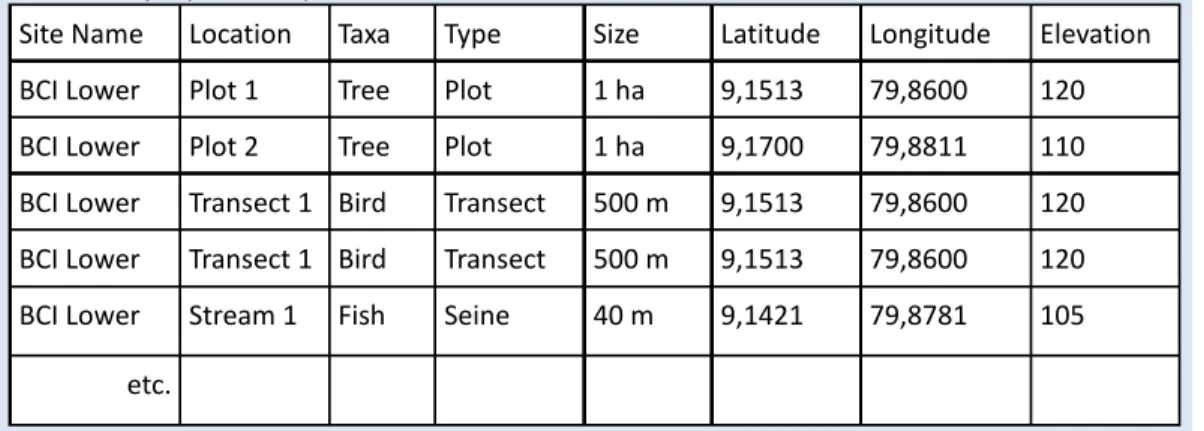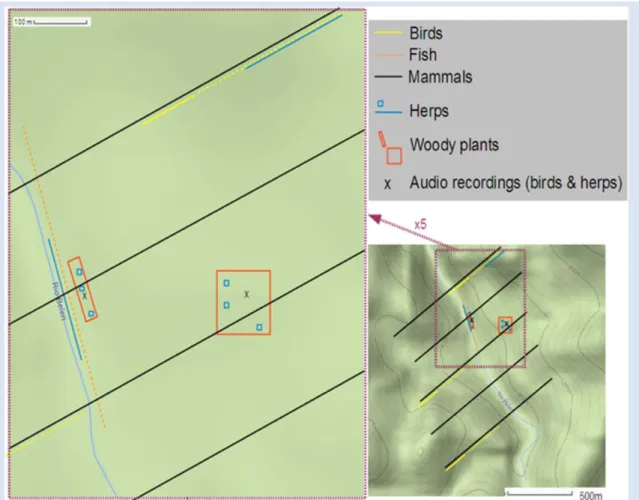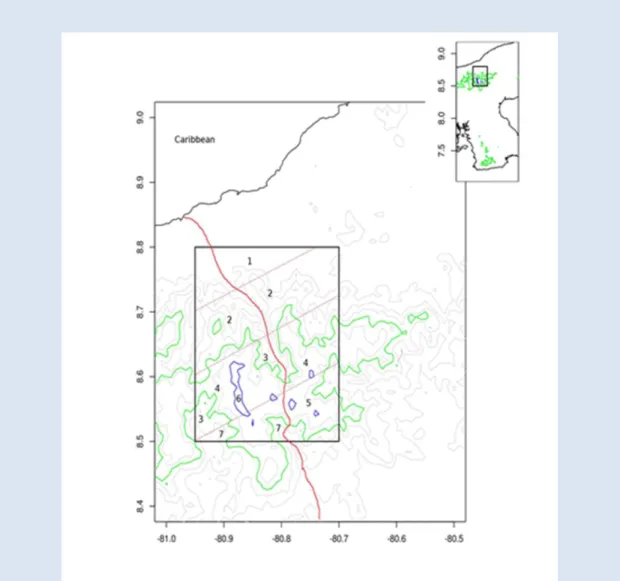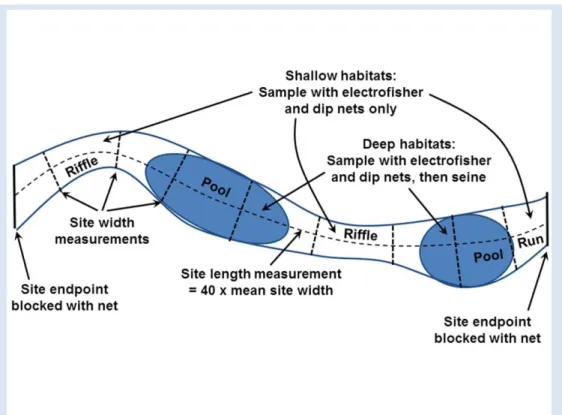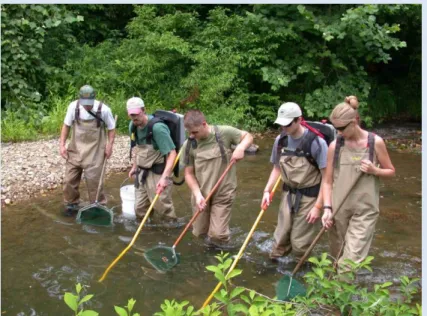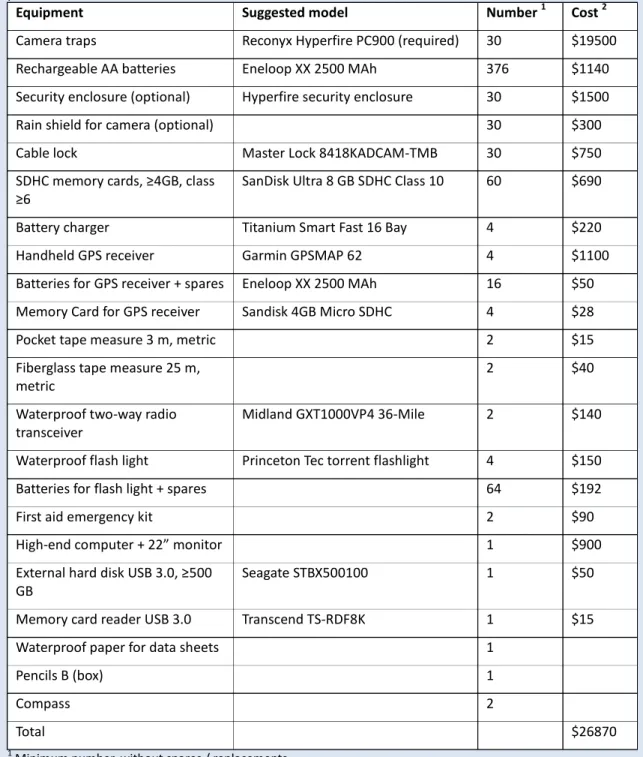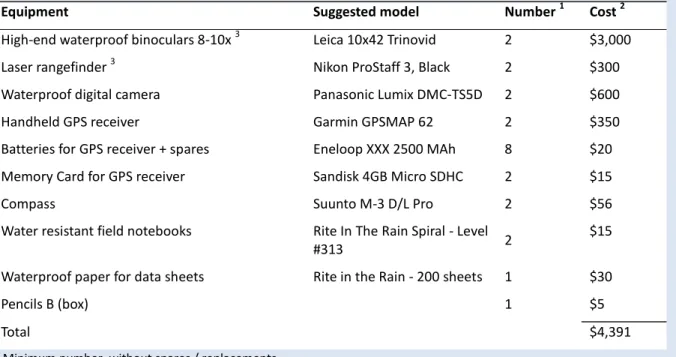Richard Condit has been a staff scientist at the Smithsonian Tropical Research Institute, Panama, for 22 years. Jansen is a research associate at the Smithsonian Tropical Research Institute, Panama, and an assistant professor at Wageningen University, the Netherlands. Rolando Alberto Pérez Mendieta works at the Center for Tropical Forest Science, Smithsonian Tropical Research Institute.
Introduction
There are many other ways in which governments will benefit from adopting the methodologies described in this manual. The methods in this manual can be used to help assess how well protected area managers are conserving biodiversity within protected areas. Other groups such as science-based non-governmental organizations, naturalists and interested private landowners may also benefit from using the methods described in this manual.
Core Methods for Establishing The Monitoring Project
- Introduction
- Site Selection
- Preliminary needs for site selection
- A random grid of sampling sites in small forests
- Larger forest sites and important heterogeneity in Panama
- Basic Taxonomic Methods
- Personnel and Training
- Permits and Legislation for the Republic of Panama
After selecting initial locations in the streams, a companion location must be selected for each of the six. Each site must be selected by generating a random stream side (ie, left or right when facing downstream) and a random number between 500 and 1000. Panama's wildlife laws can be read and downloaded from the website of the National Environment Authority.
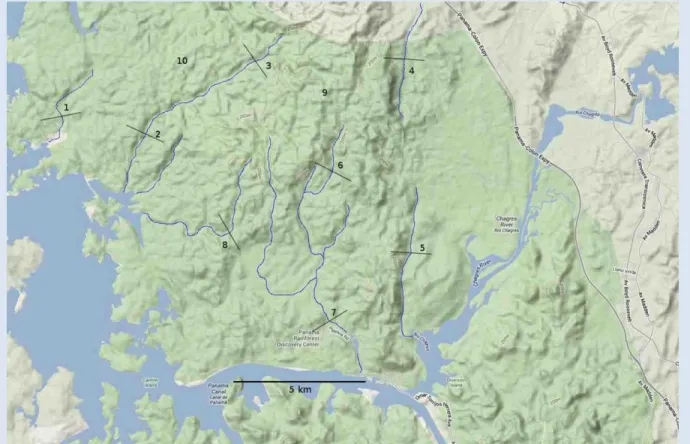
Collection Request Form
Cuando se trate de un área protegida bajo administración externa de la ANAM, será requisito indispensable presentar el permiso de acceso al área). Plazo que comprende toda la tramitación de la solicitud hasta la concesión o denegación del permiso. La UNARGEN hará los esfuerzos necesarios para responder a su solicitud a la mayor brevedad posible, dependiendo del tipo de permiso solicitado, la complejidad de la investigación a realizar, si la información proporcionada por los investigadores es correcta y la cantidad de solicitudes que tenga. sido presentado. .
2 Letter of Commitment Form
3 Informed Prior Consent Model Form
Material Transfer Agreement Form
Plantilla permiso de Importación
DATOS SOBRE LA IMPORTACIÓN DEL RECURSO Información sobre los recursos genéticos a importar Objeto de la importación:. Nota: Para elaborar el plan de trabajo, deberá tener en cuenta que la UNARGEN tendrá un plazo de cuarenta y cinco (45) días hábiles contados a partir de la fecha de recepción de su solicitud para responder a sus solicitudes de permisos de acceso. Para completar la transferencia, debe tener un Acuerdo de Transferencia de Material con la institución receptora.
Protocol for Monitoring Birds in Panama Forests
- Methods of Sampling
- Species Identification and Handling
- Personnel Training
- Estimated Budget (to date) and Timing for Panama
- Data Output
- Standardized Methods for Sampling Fishes in Streams of Panama
- Estimated Budget and Timing for Panama
The direction away from the observer of each bird when first detected should be recorded on the data sheet. Birds flying past the observer or over the transect should also be detected, but mark 'f' (from "flight") in the cue column GPS location should be recorded in the data line for the first species detected at each point count.
The following items should be stored in detail in the metadata for each bird survey project. As such, a site should be long enough to encompass the daily activities of most members of the fish community. The anode and cathode must remain under water and the electrofishing current must be applied continuously for the duration of the sample passage.
At the end of the haul, the dragline must be loaded by pulling it to the bank without obstacles. If the stream is ≤ 3 m wide, one sweeper should be used to sample the entire width of the stream. If the stream is 3-6 m wide, one sampling trawl should be used on the side of the stream that is more favorable for trawl efficiency.
Each individual fish must be identified to species in order to make a list of the species of fish present in that area.
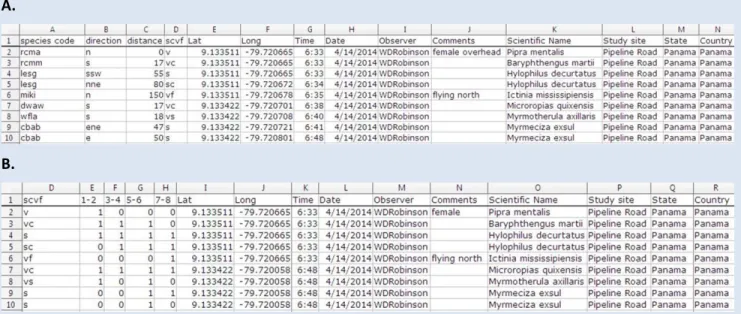
Methods for the Inventory and Monitoring of Large Mammals
The camera is aligned parallel to the ground so that the 'horizon' of the aircraft is in the center of the image. The largest costs are involved in the field deployment of camera capture in protocol 1. Start and end times should be recorded, as well as the names of the observers and basic weather information.
The caller's body temperature or air, water or substrate temperature should be measured and recorded. Personnel will require adequate supervision in all aspects of the inventory project, both in the field and in the laboratory. The coordinates of the 20x20 m square must be marked on the flag and at the top of the pole (the coordinate system is described below).
Ropes should be placed around the four edges of the 20x20 to show the boundaries clearly. This practice raises the diameter of small strains and the amount of bias should be evaluated carefully.). In addition, each of the team members should be encouraged to check each other's work.
At least one of the leaves should be placed upside down to better demonstrate the veins. Each sample should be prepared in the same way, folded in newspaper and separated from the rest of the samples with cardboard. A label with the information in the field book will be affixed to the bottom right of the board.
This person is in the field every day to monitor each team: answering questions, solving problems. Example of a tree plot database illustrating how to store the species data.
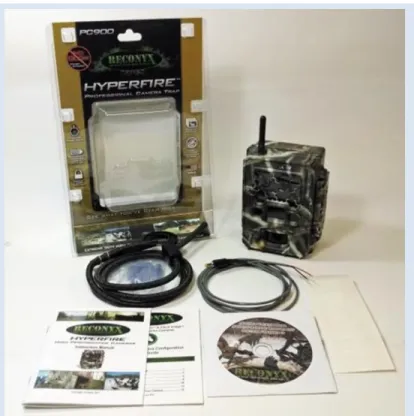
Camera trapping of terrestrial mammals and birds
Line transect counts of primates and other arboreal mammals
Methods for the Inventory and Monitoring of Amphibians and Reptiles
The amphibian and reptile surveys should be carried out at least twice a year, i.e. during the dry and wet seasons. The start and end time of the survey should be recorded, as well as the name(s) of the observer(s), the time each animal was seen, and basic weather information. The transect section must be marked with flag material at least one day before the survey.
Start and end time and location should be recorded, as well as the observer's name and basic weather information. This and additional information about the individual (e.g. activity, behavior, substrate, perch height) should be recorded. Keep in mind that observers vary in their ability to perceive animals, and measures should be taken to reduce interobserver bias.
When making these recordings, the frog must be carefully observed calling to be absolutely sure that it is the individual calling. These books collect the species of reptiles (Köhler 2008) and amphibians (Köhler 2011) present in Panama and should be used as a basic reference for their identification. This and of course all the specialized bibliography on the amphibians and reptiles of Panama, e.g. of the genus Rhadinaea (Myers 1974), are essential tools to consider for proper identification of specimens.
A la hora de recolectar especímenes, la normativa de la Autoridad Nacional del Ambiente (ANAM) establece que se debe depositar un ejemplar por especie en el Museo de Vertebrados de la Universidad de Panamá.
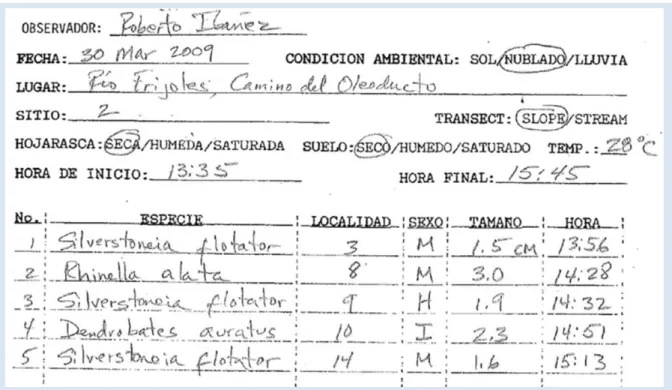
Methods for the Inventory and Monitoring of Woody Plants in Panama
Personnel and Training for the Tree Census
Since some or most of the personnel may be new to the job, adequate training prior to the project is of course crucial. As for field team leaders, this person should be someone with a professional interest in local forest biology and conservation and should have intimate knowledge of local forests and customs. Depending on the circumstances, the project may or may not need to provide salary support for this driver.
The manager should understand the project and thus be qualified to make decisions about unexpected circumstances, but of course reports to the overall project manager. A good manager must be demanding of the field workers, while being familiar with them and understanding their needs. Plot measurement work will require field teams to be in one forest area for 5-6 days.
In addition, there will be a need for at least one but preferably two data entry assistants, although these may be the same as the field technicians. Under such a plan, the field team works for three weeks setting up plots in the forest and then a week in the laboratory entering data. The project begins with the director and field managers reviewing the methods to ensure they understand all steps of field data collection.
Supervisors then present the methods to the field crews, and field workers measure the twenty test trees and compare them to the supervisors' results.
Estimated Budget and Labor for Tree Census
One of the census groups also needs three metal calipers with tenths of an accuracy; these are only needed on a small part of the plot where small trees are measured (for example Forestry Supplier model 59911; make sure it is metric). In some parts of the world, good tree climbers can be found that probably don't need a ladder. This does not include the time required to fill the 5m grid; this is usually done during a tree census.
In general, it is reasonable to assume that taxonomists will need one additional week of work for every three weeks in the field. Assuming data must be transcribed from data forms in the field, great strides in efficiency and accuracy are possible through the use of specialized data entry systems tailored to the exact format of the data sheets. One of the necessary important features is the computer's data entry screen, which exactly matches the data being transcribed: the same columns in the same order and the same headers at the top.
Plots Each plot appears once, along with any plot information, which never changes, specifically the plot's GPS coordinates and plot size. Personnel The name of each person on the project appears on one row. The reason measurements are not stored in the trunk table is that a single trunk can have more than one measurement. Additional tables of geographic and remotely sensed information can also be included in the same database.
DBH=stem diameter, with DAP=height above ground where the diameter was measured.
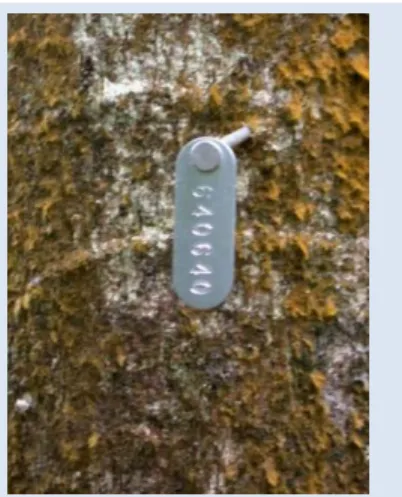
Sample Data Forms for the Tree Census and the Tree Map
Data Presentation and Analysis
- Basic Data Tables
- Basic Site-Specific Results
- Forest Biomass
- Species List
- Species Abundances and Distribution
- Species of Concern
- Indicator Species
- Species-Accumulation and Species-Area Analyses
- Summary of Forest Status
There are several routine analyzes of results per sampling site and unit that should be included in the initial report. The total number of individuals is, of course, simply the sum of the number of individuals within the two plots. The carbon stored in the forest is almost all in the trees or tree remains buried in the soil.
The table starts with the rows of the species table described in the previous section, with a column for each individual plot, transect or camera during a single census. It is particularly interesting to consider the occurrence of one animal species correlated with each of the tree species (one at a time). Each of the columns has occurrences for a single locality, and Table 8.1 – the locality table – gives the elevation of each locality.
Indeed, conservation priority should take into account these ratios of the number of threatened species in each country. The number of species at each site is then quickly found as the sum of the columns. Given a combination of any two (or more) columns from the table, the total number of species observed includes all those seen at any of the sites.
An ecosystem report on the Panama Canal: monitoring the status of the forest communities and the watershed.
